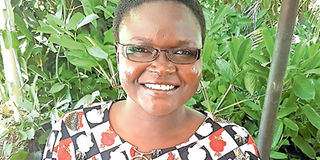I teach farmers ways to fish out cash from ponds

Mary Opiyo, a fisheries scientist at the Kenya Marine and Fisheries Research Institute (KMFRI) in Sagana. PHOTO | RACHEL KIBUI | NMG
What you need to know:
- Currently, the top fish farms are importing labour due to lack of local experts.
- There are now over 4,000 fish cages in Lake Victoria.
- There are several fish diseases but the deadly ones include fungal infections that saprolegnia, itch disease and pop eye.
- Farmers also need to be very vigilant when transferring fish from one country to another because of the current threat of tilapia lake virus.
Mary Opiyo is a fisheries scientist at the Kenya Marine and Fisheries Research Institute (KMFRI) in Sagana. Her work involves managing hatchery activities like breeding, propagation and production of mono-sex tilapia and African catfish fingerlings. She spoke to Rachel Kibui
What attracted you to aquaculture and fisheries?
It was my love for fish, in particular, and other animals. After completing secondary school, I applied to study for a BSc in fisheries and aquatic science, but some people discouraged me, noting teaching was more marketable, but I stuck to my ground.
I now have an MSc in aquaculture from Moi University and I am pursuing a PhD in fisheries science at Kenyatta University.
What does one need to get into the aquaculture profession?
The most important thing is to have interest in aquaculture and perform well in sciences, especially biology at the Form Four level. You also need to perform well in mathematics and languages.
What opportunities are there in fisheries and aquaculture, especially for the young people?
There are numerous opportunities as aquaculture technologies grow. Currently, the top fish farms are importing labour due to lack of local experts.
Others have closed down as they cannot get the right skills. There are opportunities in cage fish farming, recirculation aquaculture systems, fish breeding and cold water aquaculture, among others.
Besides, students studying entrepreneurship can get creative and venture into value addition and fish farming. Many international organisations like the United Nations Development Programme, United Nations Environment Programme and African Union-InterAfrican Bureau for Animal Resources often seek professionals in aquaculture and fisheries.
What have you done in the sector that has made a difference to small-scale fish farmers?
I am happy to have been among the experts who introduced cage farming in Lake Victoria through a partnership with Dunga Fisheries Co-operative Society back in 2013.
There are now over 4,000 fish cages in Lake Victoria. I have also been actively involved in training of fish farmers on mono-sex fish production at various hatcheries.
It is encouraging that 90 per cent of hatcheries in the country are currently engaging in mono-sex
Are there many women in the fisheries industry?
Not as many as one may wish. My prayer is to see many women join the profession. Days are gone when the association between women and fish was just fish mongering.
It is time for women to actively participate in enhancing food and nutrition security for the country. Women can get opportunities across the value chain including farming, working in hatcheries, feed production and supply.
What do you think the country should do to be fish sufficient?
We need to adopt modern ways of aquaculture to bridge the deficit gap. We should encourage more cage fish farming in Lake Victoria, marine farming at the Coast, cold water farming in central Kenya and dry land aquaculture in dry areas.
This way, there will be fish production across the country, and therefore, no need for imports.
How does one know that the quality of fingerlings they are buying is good?
The fingerlings should be active, responsive to feeds, exhibit fast growth and should have a normal fish shape without any signs of infection.
What are some of the diseases to look out for as a fish farmer?
There are several fish diseases but the deadly ones include fungal infections that saprolegnia, itch disease and pop eye.
Farmers also need to be very vigilant when transferring fish from one country to another because of the current threat of tilapia lake virus.




